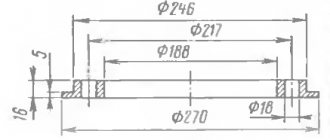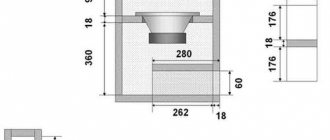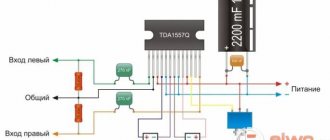Dynamic heads were produced at both the Lomo and Kinap plants . They were intended to reproduce the low-frequency range of the sound spectrum and were installed in low-frequency loudspeakers. A distinctive feature of the 2A-12 produced by Lomo is always an impregnated suspension, a dust cap made of black fabric, and a gray diffuser of a darker shade, more durable. The stamping of the suspension corrugation waves and stiffening ribs is clearer. In Samarkand 2A-12, as a rule, there is no impregnation of the suspension and these are not installed repair movements; technologically, impregnation of the suspensions was not carried out at the Samarkand Kinap plant. The dust cap is red, rarely found in black. The diffuser is devoid of any durability, like blotting paper, a light shade of gray.
Loudspeakers "Kinap" and "Lomo" - list
Description 2A-12:
Low-frequency, round dynamic head with a permanent magnet and diffuser driver. The basket is made of aluminum alloy. The moving head system consists of a diffuser, a voice coil and a centering washer. The diffuser is made of paper pulp. The diffuser is curved. The diameter of the working part of the diffuser is 285 mm, weight 31 g (±2 g). The edge of the diffuser with concentric corrugation applied to it serves as an external suspension. The centering “box” washer, made of bakelized fabric, also has concentric corrugation. The moving system is attached to the diffuser holder in two planes: along the outer edge of the diffuser and in the plane of the centering washer.
8AS-2 (AS40-8) Radio engineering
They were made by the Riga Radio Plant named after A.S. Popov.
Production began in 1973. Included in the set were Victoria 001-stereo and Victoria 002-stereo transistor radios. The 8AC-2 audio speaker also has the designation AC-40-8: AC – acoustic system (speaker), 40 – lower limit of the nominal frequency range, Hz, 8 – rated power, W. Those. characteristics:
Nominal frequency range: 40-16,000 Hz
Uneven frequency response of sound pressure no more than: 16 dB
Crossover frequency: 420 Hz and 5 kHz. Nominal Resistance: 8 Ohm Dimensions: 675x350x270 mm. Weight: 18 kg.
The acoustic system of the Victoria-001-stereo transistor radio is 3-way, it is a closed box in which direct radiation heads and filters are installed.
Speakers: LF 8 GD1-25, MF 4 GD-6, HF 3 GD-2, 6 GDV-1-16 and filters with crossover frequencies of 420 Hz and 5 kHz.
In a loudspeaker, all direct radiation heads operate in phase, which is necessary to obtain a uniform frequency response of sound pressure within its nominal frequency range. To do this, the heads are turned on taking into account the polarity of the terminals of their voice coils. The polarity of the voice coil terminals is marked on the diffuser holder of the color heads near the corresponding terminal. You can also determine the phasing of the heads yourself. To do this, by applying a positive current pulse to the sound column, you need to pay attention so that the diffusers of all heads move forward. The loudspeakers are two boxes made of plywood. All direct radiation heads are installed on the front panel of the speaker on the same vertical axis. The high-frequency and mid-frequency heads are covered with a plastic cover and filled with cotton wool to protect the low-frequency head from radiation.
The box is made of 10 mm thick laminated birch plywood. All gaps in the joints of the box walls are puttied from the inside. The back wall (also made of 10 mm thick plywood. The side walls are separated by valuable types of wood with a matte or shiny polish, and their front panels are covered with decorative radio fabric. The separating filters are mounted on a metal base, which is attached to the bottom of the box.
| 1 – capacitor C7; 2 – capacitor C6; 3 – capacitor C5; 4 – box; 5 – gasket; 6 – front board; 7 – cover of direct radiation dynamic heads of types 4GD-6 and ZGD-2; 8 – dynamic head of direct radiation type 8GD-1; 9 – capacitor C1; 10 – throttle L2; 11 – stand; 12 – capacitor SZ; 13 – throttle L1; 14 – capacitor C2; 15 – capacitor C4; 16 – throttle L3 |
8 GD1-25 4 GD-6 -160 3 GD-2, 6 GDV-1-16
Low-frequency head type 8GD-1 is fed through filter L1, C1, mid-frequency head 4GD-6 is fed through bandpass filter L2, L3, C2, SZ , the high-frequency head type ZGD-2 is connected through capacitor C4. Resistors R1 and R2 are necessary to equalize the frequency response of sound pressure.
Coils L1-L3 of the loudspeaker crossover filter are wound on cylindrical frames with a diameter of 40 mm, made of polystyrene, the winding length of coils L1 and L2 is 28 mm, and L3 is 14 mm. Coil L1 contains 310 turns, L2 - 235 and L3 - 72 turns of PEV-1 wire; 1.12.
| Throttle | Number of turns | DC resistance, Ohm | Wire brand and diameter, mm | Reel frame diameter, mm | Coil winding length, mm |
| L1 | 310±2 | 1,1±0,12 | PEV-1; 1.12 | 40 | 28 |
| L2 | 235±2 | 0,8±0,09 | PEV-1; 1.12 | 40 | 28 |
| L3 | 72±1 | 0,24±0,03 | PEV-1; 1.12 | 40 | 14 |
Mobile system 2A-12 LOMO (90s):
The magnetic circuit of the head consists of a magnet, a lower flange with a core and an upper flange, fastened together using brass pins. The height of the annular gap of the magnetic circuit with a core diameter of 52.5 mm is 12 mm, the radial width is 1.4 mm. There is a copper cap on the core.
The voice coil has 155 turns (±10 turns) wound from PEL wire with a diameter of 0.21 mm. The frame is made of aluminum foil 0.2 mm thick. The frame is an open cylinder with a groove for uniform winding. The wire is wound in two layers, each layer is coated with BF-4 glue. To glue the voice coil to the diffuser, there is a conical flange on its frame.
Removing a passive radiator from the 35AC-015 speaker system
Changing the acoustic design of the LF section 35AC-015 to a “closed box”. 1.
35 AS-015 “Electronics” - domestic 3-way floor-standing speaker with a passive radiator (link to full description). Technical characteristics: - reproduced frequency range 25 (-9 dB) - 35500 Hz - sensitivity 86 dB (0.4 Pa/√W) - frequency response unevenness in the range 100 - 8000 Hz ±4 dB - resistance 4 Ohms - minimum impedance value 3 .2 Ohm - nameplate power 130 W - short-term power 240 W - speakers used 75 GDN-1-4 (LF), 20 GDS-1-8 (MF), 6 GDV-6-16 (HF) - dimensions (HxWxD) 685x350x320 mm - weight: 25 kg
2.
The first author's modification 35AC-015 was made more than 20 years ago. A couple of speakers were modified following my S-90s. This was the second pair of speakers modified according to the scheme:
From that moment on, 35AC-015 delighted its owner. After a series of experiments with a closed box design, it was decided to abolish passive radiators.
Specifications for the 2nd modification of the AC 35AS-015: - leave the filters, speakers, housing unchanged - remove the PI - perform frequency response correction in the low-frequency region in a power amplifier under construction
The main thing is not to disturb the cat:
3.
Plugs. It was possible to pick out passive emitters without any problems:
The seat in the housing is 160*280 mm.
Emitter dimensions 157*277 mm.
Two plugs were cut from 10mm plywood:
After filing:
Fitting:
Make time to take measurements:
This is what the plug behind the decorative panel looks like:
Note: first, the PI was removed from only one column (pictured above), and the second column was removed for later. ))
Plug (for the 2nd column) after painting:
4.
Express measurements. I decided not to dismantle the woofers in order to determine the T/S parameters. Why? Yes, because no one is going to change the existing building for some other one. It is enough just to estimate the quality factor that will be obtained for the ZY.
The parameters of the LF speaker 75 GDN-1-4 are known: - main resonance frequency 25 Hz (±5 Hz) - total quality factor 0.35 (±0.05) - equivalent volume about 52 liters
In a cell with a volume of 48 liters, the quality factor will be about 0.6 (for Qts dynamics = 0.4). Super!
Comparative frequency response (microphone at the level of the woofer from a distance of 35 cm):
The graph in blue is with a passive radiator, the graph in red is without PI.
Thus, after removing the PI, an increase in the frequency response of only +6..9 dB is required.
5.
To correct the frequency response in the low frequency region, a proportional integrating filter is used, similar to that used with a 48 liter subwoofer:
The increase in frequency response is +6dB at 40 Hz compared to the transmission level at 1 kHz:
The phase response is uniform from a frequency of 40 Hz:
The “corridor” is only 40 degrees. Everything is OK here.
Solution (bass boost) spotted
in a Sanyo cassette player
Elements R4, R8, C8. Works great!
This filter was installed before the final power amplifier (after the preamplifier with volume control). Alternatively, it would be possible to use an equalizer, but due to the lack of one in the setup, they made do with a more compact and reliable solution.
6.
What has been achieved? Firstly, the low-frequency muttering characteristic of S-90 acoustic systems and their clones has gone away. Secondly, subjectively the bass has become smaller, but the quality of the bass has become much more pleasant. This is a remake for music, not film.
I must warn you that fans of low frequency chest blows will not understand this modification. Therefore, before you pick up a screwdriver, decide what is more important to you: volume or quality.
Happy experiments everyone!


